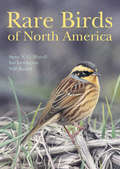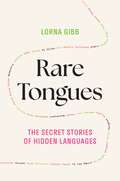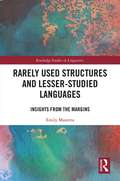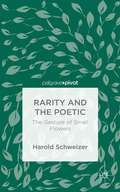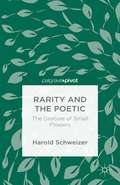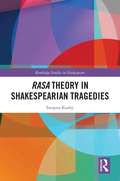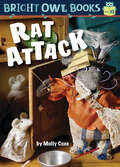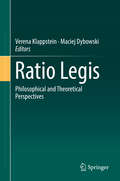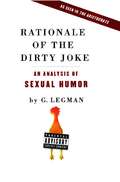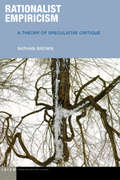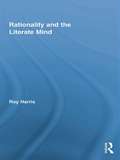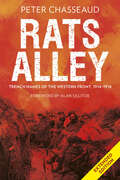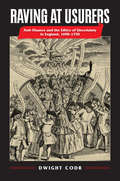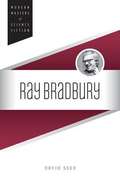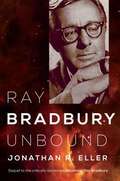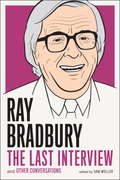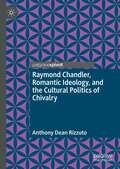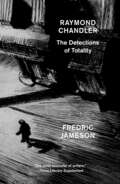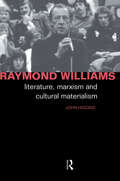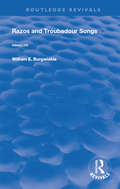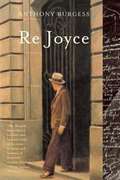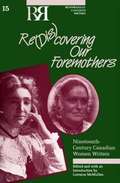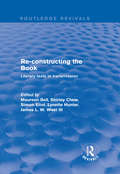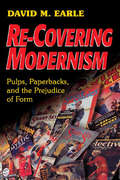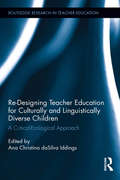- Table View
- List View
Rare Birds of North America
by Steve N. Howell Ian Lewington Will RussellThe first comprehensive illustrated guide to North America's vagrant birdsRare Birds of North America is the first comprehensive illustrated guide to the vagrant birds that occur throughout the United States and Canada. Featuring 275 stunning color plates, this book covers 262 species originating from three very different regions—the Old World, the New World tropics, and the world's oceans. It explains the causes of avian vagrancy and breaks down patterns of occurrence by region and season, enabling readers to see where, when, and why each species occurs in North America. Detailed species accounts describe key identification features, taxonomy, age, sex, distribution, and status.Rare Birds of North America provides unparalleled insights into vagrancy and avian migration, and will enrich the birding experience of anyone interested in finding and observing rare birds.Covers 262 species of vagrant birds found in the United States and CanadaFeatures 275 stunning color plates that depict every speciesExplains patterns of occurrence by region and seasonProvides an invaluable overview of vagrancy patterns and migrationIncludes detailed species accounts and cutting-edge identification tips
Rare Tongues: The Secret Stories of Hidden Languages
by Lorna GibbAn enthralling tour of the world&’s rarest and most endangered languagesLanguages and cultures are becoming increasingly homogenous, with the resulting loss of a rich linguistic tapestry reflecting unique perspectives and ways of life. Rare Tongues tells the stories of the world&’s rare and vanishing languages, revealing how each is a living testament to human resilience, adaptability, and the perennial quest for identity.Taking readers on a captivating journey of discovery, Lorna Gibb explores the histories of languages under threat or already extinct as well as those in resurgence, shedding light on their origins, development, and distinctive voices. She travels the globe—from Australia and Finland to India, the Canary Islands, Namibia, Scotland, and Paraguay—showing how these languages are not mere words and syntax but keepers of diverse worldviews, sites of ethnic conflict, and a means for finding surprising commonalities. Readers learn the basics of how various language systems work—with vowels and consonants, whistles and clicks, tonal inflections, or hand signs—and how this kaleidoscope of self-expression carries vital information about our planet, indigenous cultures and tradition, and the history and evolution of humankind.Rare Tongues is essential reading for anyone concerned about the preservation of endangered languages and an eloquent and disarmingly personal meditation on why the world&’s linguistic heritage is so fundamental to our shared experience—and why its loss should worry us all.
Rarely Used Structures and Lesser-Studied Languages: Insights from the Margins (Routledge Studies in Linguistics)
by Emily ManettaThis book investigates signature but marginal syntactic configurations influential in the development of generative theory, spotlighting lesser-studied languages of the Indic family toward illustrating the value of their study and subsequent implications for linguistic theory more broadly. After first defining what constitutes a marginal construction, the book then undertakes microcomparative approach in the rigorous exploration of fundamental properties of human language, including displacement, ellipsis, unbounded dependencies, and the role of clausal peripheries, in such languages in Kashmiri and Romani. In so doing, Manetta interrogates and ultimately affirms the relevance of marked and marginal strings which have proven to be crucial to generative syntax while simultaneously advocating the role of lesser-studied languages to the study of such properties. This book is key reading for graduate students and researchers in linguistics and syntax more specifically, as well as those interested in the study of Indic languages.
Rarity and the Poetic: The Gesture of Small Flowers
by Harold SchweizerRarity is a quality by which things flowers, leaves, light, sound fleetingly appear and disappear, leaving in their wake a resonance of something we just thought we had glimpsed. Each of the nine chapters in this book pursues such intimations of rarity in poetic ideas, images, and silences.
Rasa Theory in Shakespearian Tragedies (Routledge Studies in Shakespeare)
by Swapna KoshyThis book adds a unique eastern perspective to the ever growing corpus of Shakespeare criticism. The ancient Sanskrit theory of Rasa – the aesthete’s emotional response to performing arts – is explicated in detail and applied to Shakespeare’s tragic masterpieces. Bharata, who wrote about Rasa in the Natyasastra, developed detailed guidelines for the communication of emotion from author to actor and then to the audience culminating in a sublime aesthetic experience. Though chronologically Bharata is as ancient as Aristotle, thematically, his ideas are as relevant today as Aristotle’s is and often echo those of the Greek master. This cross–cultural study on the communication of emotions in art establishes that emotions are universal and their communication follows similar patterns in all climes. The Rasa theory is today applied to modern media like film and has found a place among audience centric communication theories. This volume extends the East-West dialogue in aesthetic theory by identifying parallels and points of deviation and delights both aesthete and critic alike.
Rat Attack (Bright Owl Books)
by Molly CoxeDiscover Bright Owl Books! This super simple beginning readers series, created by best-selling Step into Reading author and illustrator Molly Coxe, features vowel sounds – basic building blocks of reading – and only around 100 words in each book. With a note to parents and teachers at the beginning and story starters at the end, these books give kids the perfect start on educational success.Gram is making jam. Can she keep it safe from all the rat attacks? This fun photographic easy-to-read story features the short &“a&” vowel sound.
Ratio Legis: Philosophical And Theoretical Perspectives
by Verena Klappstein Maciej DybowskiThe book is dedicated to the theoretical problems concerning ratio legis. In the contexts of legal interpretation and legal reasoning, the two most important intellectual tools employed by lawyers, ratio legis would seem to offer an extremely powerful argument. Declaring the ratio legis of a statute can lead to a u-turn argumentation throughout the lifespan of the statute itself – in parliament, or in practice during court sessions, when it is tested against the constitution.Though the ratio legis argument is widely used, much about it warrants further investigation. On the general philosophical map there are many overlapping areas that concern different approaches to human rationality and to the problems of practical reasoning. Particular problems with ratio legis arise in connection with different perspectives on legal philosophy and theory, especially in terms of the methods that lawyers use for legal interpretation and argumentation. These problems can be further subdivided into particular aspects of activities undertaken by lawyers and officials who use the ratio legis in their work, and the underlying theories. In short, this book examines what ratio legis is, what it could be, and its practical implications.
Rationale of the Dirty Joke
by G. LegmanWhy do people tell dirty jokes? And what is it about a joke's dirtiness that makes it funny? G. Legman was perhaps the foremost scholar of the dirty joke, and as legions of humor writers and comedians know, his Rationale of the Dirty Joke remains the most exhaustive and authoritative study of the subject. More than two thousand jokes and folktales are presented, covering such topics as The Female Fool, The Fortunate Fart, Mutual Mismatching, and The Sex Machine. These folk texts are authentically transcribed in their innocent and sometimes violent entirety. Legman studies each for its historical and socioanalytic significance, revealing what these jokes mean to the people who tell them and to the people who listen and laugh. Here -- back in print -- is the definitive text for comedians and humor writers, Freudian scholars and late night television enthusiasts. Rationale of the Dirty Joke will amuse you, offend you, challenge you, and disgust you, all while demonstrating the intelligence and hilarity of the dirty joke.
Rationalist Empiricism: A Theory of Speculative Critique (Idiom: Inventing Writing Theory)
by Nathan BrownTwenty-first-century philosophy has been drawn into a false opposition between speculation and critique. Nathan Brown shows that the key to overcoming this antinomy is a re-engagement with the relation between rationalism and empiricism. If Kant’s transcendental philosophy attempted to displace the opposing priorities of those orientations, any speculative critique of Kant will have to re-open and consider anew the conflict and complementarity of reason and experience. Rationalist Empiricism shows that the capacity of reason and experience to extend and yet delimit each other has always been at the core of philosophy and science. Coordinating their discrepant powers, Brown argues, is what enables speculation to move forward in concert with critique.Sweeping across ancient, modern, and contemporary philosophy, as well as political theory, science, and art, Brown engages with such major thinkers as Plato, Descartes, Hume, Hegel, Marx, Heidegger, Bachelard, Althusser, Badiou, and Meillassoux. He also shows how the concepts he develops illuminate recent projects in the science of measurement and experimental digital photography. With conceptual originality and argumentative precision, Rationalist Empiricism reconfigures the history and the future of philosophy, politics, and aesthetics.
Rationality and the Literate Mind (Routledge Advances in Communication and Linguistic Theory)
by Roy HarrisThis book re-examines the old debate about the relationship between rationality and literacy. Does writing "restructure consciousness?" Do preliterate societies have a different "mind-set" from literate societies? Is reason "built in" to the way we think? How is literacy related to numeracy? Is the "logical form" that Western philosophers recognize anything more than an extrapolation from the structure of the written sentence? Is logic, as developed formally in Western education, intrinsically beyond the reach of the preliterate mind? What light, if any, do the findings of contemporary neuroscience throw on such issues? Roy Harris challenges the received mainstream opinion that reason is an intrinsic property of the human mind, and argues that the whole Western conception of rational thought, from Classical Greece down to modern symbolic logic, is a by-product of the way literacy developed in European cultures.
Rats Alley: Trench Names of the Western Front, 1914–1918
by Alan Sillitoe Peter ChasseaudWhen first published in 2006, Rats Alley was a ground-breaking piece of research, the first-ever study of trench names of the Western Front. Now, in this fully updated and revised second edition, the gazetteer has been extended to well over 20,000 trench names, complete with map references – in itself an essential tool for any First World War researcher.However, combined with the finely considered history and analysis of trench naming during the First World War, this is an edition that no military history enthusiast should be without. Discover when, how and why British trenches were first named and follow the names’ fascinating development throughout the First World War, alongside details of French and German trench-naming practices.Looked at from both contemporary and modern points of view, the names reveal the full horror of trench warfare and throw an extraordinary sidelight on the cultural life of the period, and the landscape and battles of the Western Front. Names such as Lovers Lane, Idiot Corner, Cyanide Trench, Crazy Redoubt, Doleful Post, Furies Trench, Peril Avenue, Lunatic Sap and Gangrene Alley can be placed in context.With useful information on where original trench maps are held, and how to obtain copies, Rats Alley is a vital volume for both military and family historians.
Raving at Usurers: Anti-Finance and the Ethics of Uncertainty in England, 1690-1750
by Dwight CodrIn Raving at Usurers, Dwight Codr explores the complex intersection of religion, economics, ethics, and literature in late seventeenth- and eighteenth-century England. Codr offers an alternative to the orthodox story of secular economic modernity's emergence in this key time and place, locating in early modern anti-usury literature an "ethic of uncertainty" that viewed economic transactions as ethical to the extent that their outcomes were uncertain. Codr's development of an "anti-financial" reading practice reveals that the financial revolution might be said to have grown out of--rather than in spite of--early modern anti-usury and Protestant ethics. Beginning with the reconstruction of a major controversy provoked by the delivery of a sermon against usury in the financial heart of London, Codr goes on to show not only how the ethic at the core of the discourse surrounding usury in the eighteenth century was culturally mediated but also how that ethic may be used as a lens to better understand major works of eighteenth-century literature. Codr offers radically new perspectives on Daniel Defoe's Robinson Crusoe and Henry Fielding's Tom Jones, examining how these novels reacted to emergent financial ways of knowing and meaning as well as how the texts formally bear out the possibility of a truly open and uncertain future. By reading the eighteenth century in terms of risk rather than certainty, Raving at Usurers offers a reassessment of what has been called the financial revolution in England and provides a revisionist account of the intimate connection between risk, ethics, and economics in the period.
Ray Bradbury (Modern Masters of Science Fiction)
by David SeedAs much as any individual, Ray Bradbury brought science fiction's ideas into the mainstream. Yet he transcended the genre in both form and popularity, using its trappings to explore timely social concerns and the kaleidoscope of human experience while in the process becoming one of America's most beloved authors. David Seed follows Bradbury's long career from the early short story masterpieces through his work in a wide variety of broadcast and film genres to the influential cultural commentary he spread via essays, speeches, and interviews. Mining Bradbury's classics and hard-to-find archival, literary, and cultural materials, Seed analyzes how the author's views on technology, authoritarianism, and censorship affected his art; how his Midwest of dream and dread brought his work to life; and the ways film and television influenced his creative process and visually-oriented prose style. The result is a passionate statement on Bradbury's status as an essential literary writer deserving of a place in the cultural history of his time.
Ray Bradbury Unbound
by Jonathan R. EllerIn Ray Bradbury Unbound, Jonathan R. Eller continues the story begun in his acclaimed Becoming Ray Bradbury, following the beloved author's evolution from a short story master to a multi-media creative force and outspoken visionary. At the height of his powers as a poetic prose stylist, Bradbury shifted his creative attention to film and television, where new successes gave him an enduring platform as a compelling cultural commentator. His passionate advocacy validated the U.S. space program's mission, extending his pivotal role as a chronicler of human values in an age of technological wonders. Informed by many years of interviews with Bradbury as well as an unprecedented access to personal papers and private collections, Ray Bradbury Unbound provides the definitive portrait of how a legendary American author helped shape his times.
Ray Bradbury: The Last Interview
by Ray Bradbury Sam WellerRay Bradbury was one of our most influential sci-fi writers; the visionary author of the classic Fahrenheit 451 (Granada, 1954). But he also lived a fascinating life outside the parameters of sci-fi, and was a masterful raconteur of his own story, as he reveals in his wide-ranging, in-depth final interview with his acclaimed biographer Sam Weller. Bradbury constantly twists the elements of his life into a discussion of the influences and creative processes behind his literary form.
Raymond Chandler, Romantic Ideology, and the Cultural Politics of Chivalry
by Anthony Dean RizzutoRaymond Chandler, Romantic Ideology, and the Cultural Politics of Chivalry responds to the general consensus that Philip Marlowe represents a chivalric knight out of romance. The book argues that this commonplace reading requires a stunningly rosy rewriting of Marlowe, knighthood, chivalry, and romance. The book offers a history of the cultural politics of chivalry from the Middle Ages through British Romanticism to the modern United States, exposing the elitism, violent masculinism, racism, and ethno-national othering harbored within. Rizzuto also considers the survival of the chivalric ideology after World War I, and argues that the narrative of the Great War destroying chivalry rewrites the ghastly history of warfare. Touching on Chandler throughout these cultural histories, the book then directly confronts the question of knighthood and romance in the Marlowe novels. Rizzuto identifies an explicit rejection of romance in the service of hardboiled gender, class, and genre norms, including a seldom-remarked pattern of violence against women and sexual assault. The volume concludes by offering some ideas about Chandler’s motivations and the reception of the Marlowe novels.
Raymond Chandler: The Detections of Totality
by Fredric JamesonThe master of literary theory takes on the master of the detective novelRaymond Chandler, a dazzling stylist and portrayer of American life, holds a unique place in literary history, straddling both pulp fiction and modernism. With The Big Sleep, published in 1939, he left an indelible imprint on the detective novel. Fredric Jameson offers an interpretation of Chandler's work that reconstructs both the context in which it was written and the social world or totality it projects. Chandler's invariable setting, Los Angeles, appears both as a microcosm of the United States and a prefiguration of its future: a megalopolis uniquely distributed by an unpromising nature into a variety of distinct neighborhoods and private worlds. But this essentially urban and spatial work seems also to be drawn towards a vacuum, an absence that is nothing other than death. With Chandler, the thriller genre becomes metaphysical.From the Hardcover edition.
Raymond Williams: Literature, Marxism and Cultural Materialism (Critics of the Twentieth Century)
by John HigginsRaymond Williams' prolific output is increasingly recognised as the most influential body of work on literary and cultural studies in the past fifty years. This book provides the most comprehensive study to date of the theoretical and historical context of Williams' thinking on literature, politics and culture. John Higgins traces: * Williams' intellectual development * the related growth of a New Left cultural politics * the origins of the theory and practice of cultural materialism. Raymond Williams is an astonishing achievement and will challenge many received ideas about Williams' work.
Razos and Troubadour Songs (Routledge Revivals)
by William E. BurgwinkleOriginally published in 1990, this book contains the full text and translation of razos and troubadour songs. The coupling of the razos and songs in this edition is based on the conviction that though the lyrics should first be read on their own, it is highly instructive to read the two together, as the razo authors intended. This allows the reader to attempt to read as a thirteenth-century contemporary might have.
Re Joyce
by Anthony BurgessArguing that "the appearance of difficulty is part of Joyce's big joke," Burgess provides a readable, accessible guide to the writings of James Joyce.
Re(dis)covering Our Foremothers: Nineteenth-century Canadian Women's Writers
by Lorraine McmullenThe modern literary searchlight has flushed out Canada's long neglected nineteenth century female writers. New critical approaches are advocated and others are encouraged to take on the difficulties - and rewards of research into the lives of our foremothers.
Re-Constructing the Book: Literary Texts in Transmission
by Simon Eliot Shirley Chew Maureen BellThis title was first published in 2001. Literary critics, textual editors and bibliographers, and historians of publishing have hitherto tended to publish their research as if in separate fields of enquiry. The purpose of this volume is to bring together contributions from these fields in a dialogue rooted in the transmission of texts. Arranged chronologically, so as to allow the use of individual sections relevant to period literature courses, the book offers students and teachers a set of essays designed to reflect these approaches and to signal their potential for fruitful integration. Some of the essays answer the demand "Show me what literary critics (or textual editor; or book historians) do and how they do it", and stand as examples of the different concerns, methodologies and strategies employed. Others draw attention to the potential of the approaches in combination.
Re-Covering Modernism: Pulps, Paperbacks, and the Prejudice of Form
by David M EarleIn the first half of the twentieth century, modernist works appeared not only in obscure little magazines and books published by tiny exclusive presses but also in literary reprint magazines of the 1920s, tawdry pulp magazines of the 1930s, and lurid paperbacks of the 1940s. In his nuanced exploration of the publishing and marketing of modernist works, David M. Earle questions how and why modernist literature came to be viewed as the exclusive purview of a cultural elite given its availability in such popular forums. As he examines sensational and popular manifestations of modernism, as well as their reception by critics and readers, Earle provides a methodology for reconciling formerly separate or contradictory materialist, cultural, visual, and modernist approaches to avant-garde literature. Central to Earle's innovative approach is his consideration of the physical aspects of the books and magazines - covers, dust wrappers, illustrations, cost - which become texts in their own right. Richly illustrated and accessibly written, Earle's study shows that modernism emerged in a publishing ecosystem that was both richer and more complex than has been previously documented.
Re-Designing Teacher Education for Culturally and Linguistically Diverse Students: A Critical-Ecological Approach (Routledge Research in Teacher Education)
by Ana Christina Da Silva IddingsThrough a critical-ecological lens, this book examines how to prepare preservice teachers to be resourceful and responsive practitioners in addressing the intellectual needs of children often labeled as "culturally and linguistically diverse." It explores a comprehensive re-design of a teacher education program grounded in research on the complex factors that affect the teaching and learning of linguistically and culturally diverse children. Re-Designing Teacher Education for Culturally and Linguistically Diverse Students challenges hegemonic cultural and linguistic norms, quantitative and static views of "resources," the impact of U.S. education policy, and the limited attention to the agency, identities, and strategic actions of diverse students and their families.
